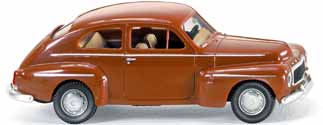Wiking Volvo PV544 Review - Wiking Recreates A Swedish Classic
Please note: The opinions expressed in our reviews are the views of the reviewer and do not necessarily reflect the views and opinions of the 1/87 Vehicle Club. model critique by Bill Cawthon
|
Volvo began selling cars in the U.S. in 1955, when the company was not even thirty years old. Two years later, in 1957, Volvo joined Isetta, Mercedes-Benz, Jaguar and Porsche as the first foreign automakers to participate in Detroit Auto Show. America has always been an important market for the Swedish company. At one time, Volvo sold more cars in the U.S. than they did at home. The first Volvo to make the trip across the Atlantic was the PV444 ("PV" stands for "personvagn," the Swedish term for passenger car). The 444 made its debut at a Stockholm exhibition in September 1944. Volvo built it as a show of optimism for better days ahead. It had 4-cylinder, 1.4-liter engine, a 3-speed transmission with floor-mounted shifter and a very reasonable price tag. It was successful beyond Volvo's dreams. The company initially intended to build just 8,000-10,000 cars, but by the time the PV444 went into production in 1947, over 12,000 had already been ordered. From 1947 to 1958, Volvo sold more than 196,000 444s. Incidentally, even Volvo admits the 444 had more than a passing resemblance to a war-era Ford. In August 1958, Volvo introduced the PV544. In reality, they had been building the 544 since late 1957 as a last-generation 444. While it is visually quite similar to the earlier car, there were many changes. A larger, curved one-piece windshield and larger rear window improved visibility. There was a new, padded dashboard for improved safety and the famous "thermometer" speedometer. Comfort was upgraded, especially for rear seat passengers. For the first time, Volvo customers could opt for a four-speed transmission and choose between two B16 4-cylinder 1583cc OHV engines: the B16A, a single-barrel carburetor version with 60 bhp or the B16B, a two-barrel "sport" version with 85 bhp. In 1959, the 544 became the first regular production car to have seat belts as standard equipment. While the 544 was a safety pioneer, it didn't set any records for performance. In 1961, the engine's displacement was bumped up to 1776cc. With the two-barrel carburetor, The B18B engine gave the car a respectable top end of over 100 mph for the first time. It was actually faster than an Alfa-Romeo Giulietta with the twin-cam engine. In addition to being a competent family hauler, the 544 was a well-respected car in the rally circuit. It was one of the most popular rally vehicles of its time and can still be found running in classic races today. In 1957, Swedish driver Gunner Andersson began driving a 544 with the new B16B engine. He placed third in the grueling Acropolis rally in Greece. The next year, Volvo hired Andersson as a factory driver. Andersson had an outstanding season, becoming the European Rally Champion. Volvos acquired a reputation for both ruggedness and reliability that few other manufacturers could match. The PV544 remained in production for nine years and went through seven series. During that time, nearly 244,000 left the factory in Göteborg. The peak year for the 544 was 1961, when Volvo sold nearly 38,000 of the little fastbacks. In December of 2001, Wiking introduced their 1/87 scale model of the PV544. It's not the first 544 model in 1/87 scale; I had a Schuco diecast version when I was a kid, and Praliné's model 3900 is still in production as Busch model 43906. However, Wiking's No. 839 01 25 is a member of the new generation of Wiking Classics. The tooling is excellent with sharply defined lines and the thinnest vent wing frames I have ever seen. The grille is blacked-out with a bright surround. The wheels are modeled after those on the prototype, one of the Busch model's weak points. Headlights and taillights are separate inserts. The taillights even have the "shoe" shape just like the real thing. As with most new Wiking models, the interior is nicely detailed and recreates the padding along the upper dash. The delicate two-spoke steering wheel is especially well done. Based on the dimensions supplied by Wayne Calder and the limitations of my measuring instruments (including a pair of 52-year-old eyes), the Wiking model looks to be right on the money. The real car was 173" long, 61.5" wide and 62.5" high and had a 102.4" wheelbase. As with all the new Wiking models, it is the printing the sets this model apart. All of the major chrome pieces are captured, right down to the Volvo name on the hood and the model designation on the trunk. One touch I liked was Wiking's decision to paint the bumpers to match the pad printing. While I am sure it is cheaper than plating, it also makes all of the "chrome" work together without the hot spots caused by chrome plating in 1/87 scale. In other words, it looks more realistic. The only complaints I might have are the lack of the floor-mounted shift and parking brake levers, both of which can be easily added if one is sufficiently detail-crazed. And there is no outside rearview mirror. Overall, this is an outstanding model of a very popular prototype. Thousands of PV544s were sold in the U.S. and many are still in use, so it can be added to an American-themed layout or diorama set anytime from 1958 to today. I am quite happy to add this new Wiking model to the inventory at Oddball's Autos and have no hesitation in recommending it to you. - Bill Cawthon Click here for an Adobe Acrobat version Wiking 839 01 25: 1958 Volvo PV544 sedan. Made by: Imported by: |


